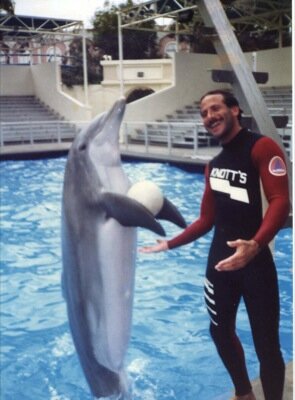THE DIFFERENCE
The clicker and whistle were used this way for years, and the animals remained very very consistent. But something amazing happened in the late 70's and early 80's. Some very good trainers that I learned from at Sea World started taking it a step further and actually advanced the use of the clicker and whistle from the constant clicking and feeding to a whole other level!
They decided to not necessarily feed the animal every time they blew the whistle or clicked the clicker. This means that when the animal came back to the stage, he might have been sent off on another behavior without a reward. Why would the animal take off on another behavior without getting a reward? Lets go back to basic behavior and the pigeon. A pigeon is in a cage. He hits a lever with his beak, and gets a seed. He does it again and gets another seed. Over time he learns that he hits the lever and gets a seed. But lets say one time, he hits the lever and does not get the seed. What will he do? He will hit the lever again! But harder!
It was a fact that if you did not reward the animal all the time, and sent the animal on another behavior, the next behavior's height would be higher. This intermittent rewarding created attitude, energy, and drive.
We also began to vary the types rewards too, in that they did not always give a food reward. The reward that they used might have been a game, or something else that the animal liked. The bottom line is that the clicker or whistle got to a point where it DID NOT necessarily mean food or a treat. It became a form of communication that told the animal that he did the behavior correctly.
 |
|
This is was one very cool dolphin named Happy that I trained in 1986. She loved playing with balls and other types of toys as you can see. Balls are actually just as reinforcing as fish with many marine mammals.
|
Much like what I learned over 25 years ago, when I use a clicker with a dog, I do not feed a treat every time after I click. Nor do I always use a treat as a reward. I will use a treat about 50% of the time, and 50% of the time either actually use a different reward, or possibly ask for another behavior.
This is the major difference between what I have read about how most people clicker train dogs. Almost all of them will tell you to feed a treat after each time you click.
CLICKER HOME Read on>>
HOW DOES A CLICKER WORK? Read on>>
THE DIFFERENCE BETWEEN USING A CLICKER WITH A MARINE MAMMAL AND A DOG Read on>>
THE DIFFERENCE BETWEEN MY STYLE AND OTHERS
WHAT CAN VARYING THE REWARDING OF THE ANIMAL ACCOMPLISH? Read on>>
WHAT CAN CONSTANT CLICKING AND FEEDING CREATE? Read on>>
SHOULD I USE A CLICKER ON ALL DOGS? Read on>>
SHOULD I USE A CLICKER ON ALL BEHAVIORS I TRAIN? Read on>>
YOUR DOG'S POTENTIAL Read on>>


